B) False
Correct Answer

verified
Correct Answer
verified
Multiple Choice
Figure 2-7 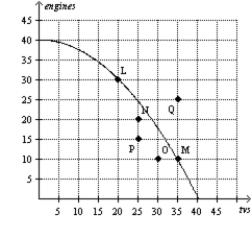 -Refer to Figure 2-7. Unemployment could cause this economy to produce at which point(s) ?
-Refer to Figure 2-7. Unemployment could cause this economy to produce at which point(s) ?
A) L, M
B) N, O, P, Q
C) N, O, P
D) Q
F) A) and C)
Correct Answer

verified
Correct Answer
verified
Multiple Choice
Figure 2-9
Panel (a) Panel (b)
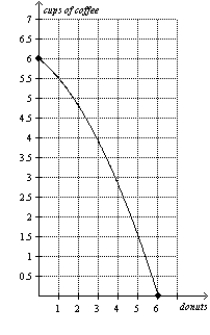
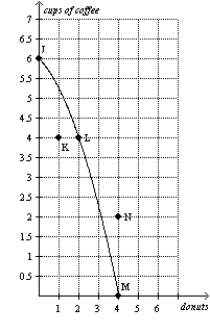 -Refer to Figure 2-9, Panel (a) . The opportunity cost of moving from point J to point L is
-Refer to Figure 2-9, Panel (a) . The opportunity cost of moving from point J to point L is
A) 2 donuts.
B) 2 donuts and 2 cups of coffee.
C) 2 cups of coffee.
D) 6 cups of coffee.
F) C) and D)
Correct Answer

verified
Correct Answer
verified
True/False
Figure 2-23 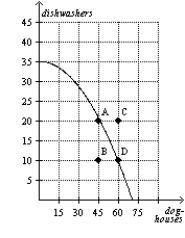 -Refer to Figure 2-23. Points A, B, and D represent feasible outcomes for this economy.
-Refer to Figure 2-23. Points A, B, and D represent feasible outcomes for this economy.
B) False
Correct Answer

verified
Correct Answer
verified
Multiple Choice
Figure 2-6 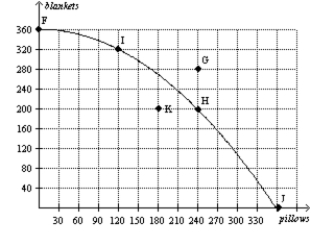 -Refer to Figure 2-6. If this economy devotes all of its resources to the production of blankets, then it will produce
-Refer to Figure 2-6. If this economy devotes all of its resources to the production of blankets, then it will produce
A) 0 blankets and 360 pillows.
B) 200 blankets and 240 pillows.
C) 320 blankets and 120 pillows.
D) 360 blankets and 0 pillows.
F) B) and C)
Correct Answer

verified
Correct Answer
verified
True/False
When two variables move in opposite directions, the curve relating them is upward sloping, and we say the variables are positively related.
B) False
Correct Answer

verified
Correct Answer
verified
Multiple Choice
Which types of models are built with assumptions?
A) economic models, but not models in other disciplines such as physics and biology
B) economic models as well as models in other disciplines such as physics and biology
C) models that are built for teaching purposes but not for research purposes
D) bad models
F) A) and C)
Correct Answer

verified
Correct Answer
verified
Multiple Choice
The simple circular-flow diagram is a model that includes only some key players in the real economy. Which of the following key players are omitted from the simple circular-flow model?
A) households
B) firms
C) government
D) markets for factors of production
F) A) and B)
Correct Answer

verified
Correct Answer
verified
Multiple Choice
Which markets are represented in the simple circular-flow diagram?
A) markets for goods and services and markets for financial assets
B) markets for factors of production and markets for financial assets
C) markets for goods and services and markets for factors of production
D) markets for goods and services and markets for imports and exports
F) A) and C)
Correct Answer

verified
Correct Answer
verified
Multiple Choice
Figure 2-20
Relationship Between Years of Education and Annual Income 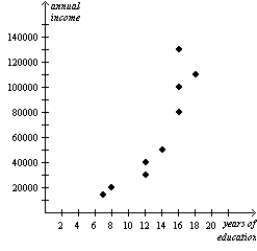 -Refer to Figure 2-20. The graph above is a
-Refer to Figure 2-20. The graph above is a
A) bar graph
B) scatterplot
C) pie chart
D) time series analysis
F) A) and B)
Correct Answer

verified
Correct Answer
verified
Short Answer
Is the following a positive or normative statement? The Federal Reserve should set an inflation target and employ policies to meet the target.
Correct Answer

verified
Correct Answer
verified
True/False
Economic models can help us understand reality only when they include all details of the economy.
B) False
Correct Answer

verified
Correct Answer
verified
Multiple Choice
Figure 2-18
Relationship between Price and Restaurant Meals 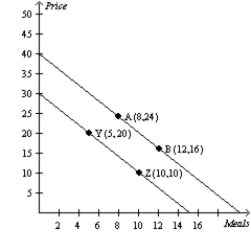 -Refer to Figure 2-18. The slope of the line containing points Y and Z is
-Refer to Figure 2-18. The slope of the line containing points Y and Z is
A) -0.5.
B) -1.
C) -2.
D) -4.
F) A) and C)
Correct Answer

verified
Correct Answer
verified
Multiple Choice
Figure 2-2 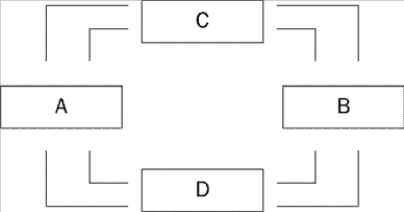 -Refer to Figure 2-2. If Box A of this circular-flow diagram represents firms, then which box represents households?
-Refer to Figure 2-2. If Box A of this circular-flow diagram represents firms, then which box represents households?
A) Box B
B) Box C
C) Box D
D) Any one of the other boxes (B, C, or D) could represent households.
F) All of the above
Correct Answer

verified
Correct Answer
verified
Multiple Choice
Figure 2-7  -Refer to Figure 2-7. Efficient production is represented by which point(s) ?
-Refer to Figure 2-7. Efficient production is represented by which point(s) ?
A) L, M
B) L, M, N, P, Q
C) N, O, P
D) Q
F) A) and B)
Correct Answer

verified
Correct Answer
verified
Multiple Choice
Economists at the Department of the Treasury
A) design U.S. currency and coins.
B) provide Congress with the annual budget.
C) enforce the U.S. antitrust laws.
D) provide advice on tax policy to the President.
F) A) and D)
Correct Answer

verified
Correct Answer
verified
Multiple Choice
In the circular-flow diagram, which of the following items flows from firms to households through the markets for the factors of production?
A) goods and services
B) land, labor, and capital
C) dollars spent on goods and services
D) wages, rent, and profit
F) None of the above
Correct Answer

verified
Correct Answer
verified
Multiple Choice
Policies such as rent control and trade barriers persist in spite of the fact that economists are virtually united in their opposition to such policies, probably because
A) economists have not yet convinced the general public that the policies are undesirable.
B) economists engage in positive analysis, not normative analysis.
C) economists have values that are different from the values of most non-economists.
D) economists' theories are not easily confirmed or refuted in laboratory analysis.
F) A) and B)
Correct Answer

verified
Correct Answer
verified
Multiple Choice
Normative statements are
A) not usually made by economists.
B) claims about how the world should be.
C) claims about how variables in the economy normally behave.
D) pessimistic interpretations of the economy.
F) B) and D)
Correct Answer

verified
Correct Answer
verified
Multiple Choice
Sometimes economists disagree because their scientific judgments differ. Which of the following instances best reflects this source of disagreement?
A) One economist believes everyone should pay the same percentage of their income in taxes; another economist believes that wealthier citizens should pay a higher percentage of their income in taxes.
B) One economist believes that manufacturing firms should face greater regulation to preserve the environment; another economist believes the government should not intervene in free markets.
C) One economist believes that equality should be valued over efficiency in policy decisions; another economist believes that efficiency should be valued over equality in policy decisions.
D) One economist believes the government should tax a household's income; another economist believes the government should tax a household's consumption.
F) None of the above
Correct Answer

verified
Correct Answer
verified
Showing 201 - 220 of 617
Related Exams